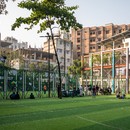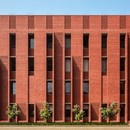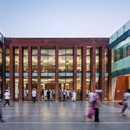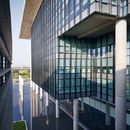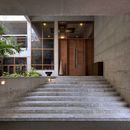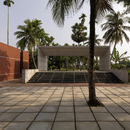- Home
- Architects
- Interviews
- World premiere: interview with Rafiq Azam
World premiere: interview with Rafiq Azam
Biography
How important to you is the place, the context for one of your buildings?
I’m always excited when I have to go visit a site where a new building will stand. A strange thing happens as I pace back and forth: the site talks to me – it tells me about its history, the context, the landscape, the climate, every single aspect that affects the location. I find myself listening to the site and learning from it; then I fall in love and that’s how the project kicks off.
I read that being an architect wasn’t exactly a vocation for you...
It was a really interesting challenge for me to become an architect because I never really wanted to be one; in actual fact, I always wanted to be a painter. So, when I can, I start designing as if I were a painter, attempting to develop the relationship between the architectural vision and the pictorial vision, so my architecture has become “watercolours”.
Bangladesh is not a tourist destination and the media rarely reports news about what is happening there, about the living conditions and the social changes. Tell us something about how things are changing in Dacca, the cities and the whole country.
The traffic is having a huge effect on the Dacca cityscape, along with the population growth caused by lack of work in the villages and subsequent emigration of people to seek a better lot in the city. This of course means that the capital, like other urban realities, is becoming more and more crowded. Luckily, we Bengali are starting to realise that our country is in urgent need of green to build a sustainable society.
So architects have turned into modern day activists. Architecture is not just an affirmation of one’s personality, it’s an expression of the whole society, it’s a collective phenomenon. So I started to think that we have a huge responsibility towards others and we need to be fully aware of which and what kind of architecture we need to build in our country. Bangladesh is a nation with a long history but if we architects forget our history, we have no roots to guide us, no rules and regulations.
What are the cornerstones of your “architecture for green living”?
My practice is called Shatotto, architecture for green living, because we maximise natural ventilation, the benefits of water, the presence of nature in order to reduce energy consumption, the demand for electricity, and therefore pollution from fossil fuels. Another extremely important issue for us, operating in Bangladesh is the choice of materials, because we are forced to take into account their availability and how easy it is to procure them as well as their interaction with the territory. Indeed, in our country, life is particularly influenced by the climate; we are also a seismic zone and a huge population lives in a confined area. So, considering each of these aspects, I prefer to use two materials in particular – concrete and brick – both of which have many connections with history and sociology as well as the advantage of being weather and earthquake resistant.

What do you love about this profession and why did you end up deciding to be an architect?
I believe the human being must be at the centre, we architects work for people. I often cite the example of Vincent van Gogh, who despite all the torments he suffered during his life and despite that fact that his contemporaries never truly recognised his genius, wrote the phrase “There is nothing more artistic than to love people”. To me, this is a surprising statement: the goal of every profession should be to do good for others, in order to do good deeds for a whole nation. Obviously, this is how it must be for architecture.
(Mara Corradi)
Interview
How important to you is the place, the context for one of your buildings?
I’m always excited when I have to go visit a site where a new building will stand. A strange thing happens as I pace back and forth: the site talks to me – it tells me about its history, the context, the landscape, the climate, every single aspect that affects the location. I find myself listening to the site and learning from it; then I fall in love and that’s how the project kicks off.
I read that being an architect wasn’t exactly a vocation for you...
It was a really interesting challenge for me to become an architect because I never really wanted to be one; in actual fact, I always wanted to be a painter. So, when I can, I start designing as if I were a painter, attempting to develop the relationship between the architectural vision and the pictorial vision, so my architecture has become “watercolours”.
Bangladesh is not a tourist destination and the media rarely reports news about what is happening there, about the living conditions and the social changes. Tell us something about how things are changing in Dacca, the cities and the whole country.
The traffic is having a huge effect on the Dacca cityscape, along with the population growth caused by lack of work in the villages and subsequent emigration of people to seek a better lot in the city. This of course means that the capital, like other urban realities, is becoming more and more crowded. Luckily, we Bengali are starting to realise that our country is in urgent need of green to build a sustainable society.
So architects have turned into modern day activists. Architecture is not just an affirmation of one’s personality, it’s an expression of the whole society, it’s a collective phenomenon. So I started to think that we have a huge responsibility towards others and we need to be fully aware of which and what kind of architecture we need to build in our country. Bangladesh is a nation with a long history but if we architects forget our history, we have no roots to guide us, no rules and regulations.
What are the cornerstones of your “architecture for green living”?
My practice is called Shatotto, architecture for green living, because we maximise natural ventilation, the benefits of water, the presence of nature in order to reduce energy consumption, the demand for electricity, and therefore pollution from fossil fuels. Another extremely important issue for us, operating in Bangladesh is the choice of materials, because we are forced to take into account their availability and how easy it is to procure them as well as their interaction with the territory. Indeed, in our country, life is particularly influenced by the climate; we are also a seismic zone and a huge population lives in a confined area. So, considering each of these aspects, I prefer to use two materials in particular – concrete and brick – both of which have many connections with history and sociology as well as the advantage of being weather and earthquake resistant.

What do you love about this profession and why did you end up deciding to be an architect?
I believe the human being must be at the centre, we architects work for people. I often cite the example of Vincent van Gogh, who despite all the torments he suffered during his life and despite that fact that his contemporaries never truly recognised his genius, wrote the phrase “There is nothing more artistic than to love people”. To me, this is a surprising statement: the goal of every profession should be to do good for others, in order to do good deeds for a whole nation. Obviously, this is how it must be for architecture.
(Mara Corradi)
Related Articles: Rafiq Azam, Shatotto architecture for green living
Related Articles: Rafiq Azam (SHATOTTO Architecture for Green Living)
Related Articles







